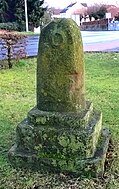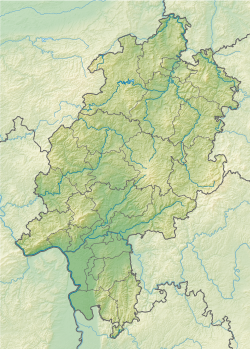Menhir from Gelnhausen-Meerholz
| Menhir from Gelnhausen-Meerholz Gate stone | ||
|---|---|---|
|
Menhir made of sea wood |
||
|
|
||
| Coordinates | 50 ° 10 '58.5 " N , 9 ° 8' 14.4" E | |
| place | Gelnhausen , OT Meerholz , Hesse , Germany | |
| Emergence | 2800 to 2200 BC Chr. | |
The 1.03 m high menhir from Gelnhausen-Meerholz is a menhir (also called gate stone or goose bank) in Meerholz in the Main-Kinzig district and probably dates from the late Neolithic .
Finding and setting up
The stone was found in 1929 on Rathausstrasse in Meerholz while a gas pipeline was being built. The block of red-brown quartzitic sandstone was set up by the Spessart Association in a green area on the B43 in Gelnhausen- Meerholz and bears the inscription 'Am alten Pfortenstein'. The stone was interpreted as a menhir with a pictorial representation.
The original location of the installation could not be identified, but numerous ceramic sites are known from the central Kinzig valley .
Dating
The entire surface of the stone is worked off by picking. One side of the stone bears three raised images. These are (also from Tim Kerig as copper ax Hammeraxt or Schaftröhrenaxt called) type Eschollbrücken (Object 2) and as a copper collar (Object 3) interpreted. Such copper axes were never found in graves, but often as individual finds. They are often interpreted as landfills . According to Müller-Karpe, these are magnificent axes. Josef Maran dates them to the cord ceramics.
According to Kerig , the resemblance to the stone from Müächen - Langeneichstädt in the Saalekreis , the stone slab from Dingelstedt , Harz district and the menhir from Seehausen , Börde district indicate a time between Salzmünde ( funnel cup culture ) and the Aunjetitz culture , most likely in cord pottery .
Kerig connects the Meerholzer Steins with the common European statue menhirs . Against this background, menhir and metal objects are interpreted by Kerig as indications of an end-Neolithic " meritarian economy " of limited scope.
See also
literature
- Johannes Groht : Menhirs in Germany. State Office for Monument Preservation and Archeology Saxony-Anhalt, Halle (Saale) 2013, ISBN 978-3-943904-18-5 , pp. 53, 139, 149–150.
- Tim Kerig: A statue menhir depicting an ax of the Eschollbrücken type? To an enigmatic stone monument from Gelnhausen-Meerholz (Main-Kinzig-Kreis). In: Prehistorische Zeitschrift , Volume 85, 2010, pp. 59–78.
Web links
- The Megalithic Portal: Gate Stone
- photos
- Description A statue menhir depicting an ax of the Eschollbrücken type
Individual evidence
- ↑ Hans Kreutzer, The old "gate stone" or the "goose bench" in Meerholz. Heimat-Jahrbuch Gelnhausen 1981, 51–52
- ↑ Tim Kerig, A statue menhir depicting an ax of the Eschollbrücken type? To an enigmatic stone monument from Gelnhausen-Meerholz (Main-Kinzig-Kreis). In: Prehistoric Journal Volume 85, 2010, p. 62
- ↑ Tim Kerig, A statue menhir depicting an ax of the Eschollbrücken type? To an enigmatic stone monument from Gelnhausen-Meerholz (Main-Kinzig-Kreis). In: Prehistoric Journal Volume 85, 2010, p. 71
- ↑ Tim Kerig, A statue menhir depicting an ax of the Eschollbrücken type? To an enigmatic stone monument from Gelnhausen-Meerholz (Main-Kinzig-Kreis). In: Prehistoric Journal Volume 85, 2010, p. 71
- ^ Hermann Müller-Karpe, On Copper Age Culture in Hesse. Find reports from Hessen 14, 1974 (1975), 220
- ↑ Josef Maran, On the time and interpretation of the copper axes of the Eschollbrücken type. In: Falkenstein, Sabine Schade-Lindig, Andrea Zeeb-Lanz (eds.), Kumpf, Kalotte, Pfeilschaftglätter: Two lives for archeology. Commemorative letter for Annemarie Häusser and Helmut Spatz. Rahden / Westf., Leidorf 2008, 173–187
- ↑ Tim Kerig, A statue menhir depicting an ax of the Eschollbrücken type? To an enigmatic stone monument from Gelnhausen-Meerholz (Main-Kinzig-Kreis). In: Prehistoric Journal Volume 85, 2010, p. 70
- ↑ Tim Kerig, A statue menhir depicting an ax of the Eschollbrücken type? To an enigmatic stone monument from Gelnhausen-Meerholz (Main-Kinzig-Kreis). In: Prehistoric Journal Volume 85, 2010, p. 75

